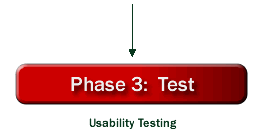

This is the third phase of our Web development process. Web site usability testing is understanding how a visitor navigates, finds information and interacts with your Web site. This should be done in a one-on-one situation where the tester uses a "watch and learn" approach. The results of the session should be used to improve your user's experience. Hiring an expert in the "usability testing" field should be considered whenever possible.
Informal testing can be an effective way to find the major usability problems. A simple test plan and task list is prepared, which is observed and noted by an impartial moderator. Follow the guidelines as described below to help you conduct a usability test.
When conducting a usability test of your own site, it should be fairly easy to come up with a list of tasks you expect visitors to perform. However, when you're performing a test of someone else's site, you will need to familiarize yourself with the site's purpose and functions. Based on your understanding of the site's purpose/goal, you should compose tasks that will measure if those goals are being met. You should come up with a set of questions/tasks that could be answered in about an hour. Any less than that and the users aren't getting involved enough to make it interesting; any more and they are likely to get burned out. It is a good idea to have a printout of the site for note taking.
Here are a few sample questions/tasks that I might ask if I were conducting a usability test on travel site:
Informal testing usually takes place in a casual office setting. The participants are often friends, family or co-workers. If you have developed a user profile for your site, try and select participants that match that profile. A group of about three or four participants is adequate for an informal test.
You should conduct the test one person at a time. They can come to your office or you could offer to go to theirs. Introduce yourself and explain the process and purpose of the test. Explain that you are the silent observer, not the helper. You will be taking notes and speaking only when giving a new task.
Write down as much of what they were doing as possible, including button presses, page visits and scrolls. By watching the screen pointer, you can often tell where they are looking. For more formal user tests, you would likely need another note taker and/or a video camera so that you wouldn't miss anything important. Write down everything they say aloud. Statements like, "This is terribly slow" are critical in your test results.
Once the tests are complete, collect and analyze the data. Some questions to ask yourself are:
Write the report while the test is still fresh in your mind. Summarize all the data showing the results of each task, problem areas, comments, and user feedback.
Analyze the data by finding out why there was difficulty or what was the source of the problem. Identify global or broad-scope issues and specific task-oriented issues. Compile all the information and make recommendations. Divide the recommendations into short and long term goals. Make a plan and decide how you can meet your goals.
Sample MPS Test -- Sample MPS Observer
-- Return to Web Development Process Page --